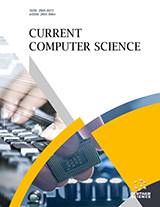Abstract
Background: Cardiovascular diseases are increasing at an alarming rate with a very high rate of mortality. Coronary artery disease is one of the types of cardiovascular diseases, which is not easily diagnosed in its early stage. Prevention of coronary artery disease is possible only if it is diagnosed at an early stage and proper medication is done.
Objective: An effective diagnosis model is important not only for the early diagnosis but also to check the severity of the disease. Method: In this paper, a hybrid approach is followed, with the integration of deep learning (multilayer perceptron) with case-based reasoning to design an analytical framework. This paper suggests two phases of the study, one in which the patient is diagnosed for coronary artery disease and in the second phase, if the patient is found suffering from the disease, then case-based reasoning is employed to diagnose the severity of the disease. In the first phase, a multilayer perceptron is implemented on a reduced dataset and with time-based learning for stochastic gradient descent, respectively. Results: The classification accuracy increased by 4.18 % with reduced data set using a deep neural network with time-based learning. In the second phase, when the patient was diagnosedpositive for coronary artery disease, then the case-based reasoning system was used to retrieve from the case base the most similar case to predict the severity of the disease for that patient. The CBR model achieved 97.3% accuracy. Conclusion: The model can be very useful for medical practitioners, supporting in the decisionmaking process and thus can save the patients from unnecessary medical expenses on costly tests and can improve the quality and effectiveness of medical treatment.Keywords: Artificial Neural Network, cardiovascular disease, coronary artery disease, Case-based reasoning, multi-layer perceptron, medical treatment.
Graphical Abstract
Recent Advances in Computer Science and Communications
Title:Identification of Coronary Artery Disease using Artificial Neural Network and Case-Based Reasoning
Volume: 14 Issue: 8
Author(s): Varun Sapra, M.L Saini and Luxmi Verma*
Affiliation:
- Chitkara University Institute of Engineering and Technology, Chitkara University, Punjab,India
Keywords: Artificial Neural Network, cardiovascular disease, coronary artery disease, Case-based reasoning, multi-layer perceptron, medical treatment.
Abstract: Background: Cardiovascular diseases are increasing at an alarming rate with a very high rate of mortality. Coronary artery disease is one of the types of cardiovascular diseases, which is not easily diagnosed in its early stage. Prevention of coronary artery disease is possible only if it is diagnosed at an early stage and proper medication is done.
Objective: An effective diagnosis model is important not only for the early diagnosis but also to check the severity of the disease. Method: In this paper, a hybrid approach is followed, with the integration of deep learning (multilayer perceptron) with case-based reasoning to design an analytical framework. This paper suggests two phases of the study, one in which the patient is diagnosed for coronary artery disease and in the second phase, if the patient is found suffering from the disease, then case-based reasoning is employed to diagnose the severity of the disease. In the first phase, a multilayer perceptron is implemented on a reduced dataset and with time-based learning for stochastic gradient descent, respectively. Results: The classification accuracy increased by 4.18 % with reduced data set using a deep neural network with time-based learning. In the second phase, when the patient was diagnosedpositive for coronary artery disease, then the case-based reasoning system was used to retrieve from the case base the most similar case to predict the severity of the disease for that patient. The CBR model achieved 97.3% accuracy. Conclusion: The model can be very useful for medical practitioners, supporting in the decisionmaking process and thus can save the patients from unnecessary medical expenses on costly tests and can improve the quality and effectiveness of medical treatment.Export Options
About this article
Cite this article as:
Sapra Varun , Saini M.L and Verma Luxmi *, Identification of Coronary Artery Disease using Artificial Neural Network and Case-Based Reasoning, Recent Advances in Computer Science and Communications 2021; 14 (8) . https://dx.doi.org/10.2174/2666255813999200613225404
| DOI https://dx.doi.org/10.2174/2666255813999200613225404 |
Print ISSN 2666-2558 |
| Publisher Name Bentham Science Publisher |
Online ISSN 2666-2566 |
 5
5
- Author Guidelines
- Bentham Author Support Services (BASS)
- Graphical Abstracts
- Fabricating and Stating False Information
- Research Misconduct
- Post Publication Discussions and Corrections
- Publishing Ethics and Rectitude
- Increase Visibility of Your Article
- Archiving Policies
- Peer Review Workflow
- Order Your Article Before Print
- Promote Your Article
- Manuscript Transfer Facility
- Editorial Policies
- Allegations from Whistleblowers
Related Articles
-
Strategies for Non-Invasive Molecular Imaging of Acute Allograft Rejection by Gamma Scintigraphy and Positron Emission Tomography
Current Radiopharmaceuticals Low-Molecular-Weight-Heparins: A Review of Literature
Vascular Disease Prevention (Discontinued) Growth Factors and Astrocytes Metabolism: Possible Roles for Platelet Derived Growth Factor
Medicinal Chemistry Recent Patents on PCSK9: A New Target for Treating Hypercholesterolemia
Recent Patents on DNA & Gene Sequences Herbal Phytochemicals as Immunomodulators
Current Immunology Reviews (Discontinued) The Mammalian Innate Immune System: Potential Targets for Drug Development
Current Drug Targets - Immune, Endocrine & Metabolic Disorders Cardiovascular Disease Burden and Risk Factors Before and After Kidney Transplant
Cardiovascular & Hematological Disorders-Drug Targets Bilitranslocase is Involved in the Uptake of Bromosulfophthalein in Rat and Human Liver
Drug Metabolism Letters Insulinoma Case Admitted with Reactive Hypoglycemia Symptoms
Current Diabetes Reviews Therapeutic Management of COVID-19 Patients: Clinical Manifestation and Limitations
Current Pharmaceutical Design Neuroprotective Properties of Peroxisome Proliferator-Activated Receptor Alpha (PPARα) and its Lipid Ligands
Current Medicinal Chemistry Triple Antithrombotic Therapy vs. Double Antithrombotic Therapy: One Scenario, 8 Questions, Many Conclusions
Current Cardiology Reviews Blood-Brain Barrier Integrity and Glial Support: Mechanisms that can be Targeted for Novel Therapeutic Approaches in Stroke
Current Pharmaceutical Design The Autocrine/Paracrine Loop After Myocardial Stretch: Mineralocorticoid Receptor Activation
Current Cardiology Reviews Pharmacophore Modeling, Synthesis, Scaffold Hopping and Biological β- Hematin Inhibition Interaction Studies for Anti-malaria Compounds
Current Topics in Medicinal Chemistry Using Serum Biomarkers for Identifying Unstable Carotid Plaque: Update of Current Evidence
Current Pharmaceutical Design A Cyclooxygenase-2 Inhibitor Reduces Vascular Wall Thickness and Ameliorates Cognitive Impairment in a Cerebral Small Vessel Diseases Rat Model
Current Alzheimer Research Cytochrome P450 in Neurological Disease
Current Drug Metabolism Aminoalkylpyridines (AAPs), Triazoline Metabolite Analogues, As Anticonvulsants Highly Effective in the Mes Test
Current Medicinal Chemistry NADPH Oxidases in the Heart
Current Cardiology Reviews























